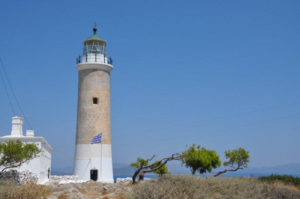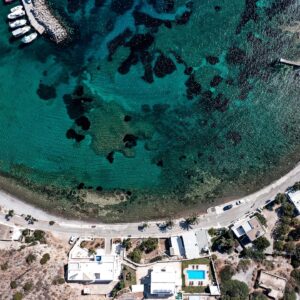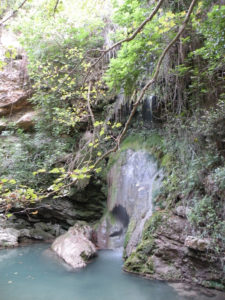Located off the south-eastern edge of the Peloponnese, Kythera Island has always been an important crossroads for the eastern Mediterranean. As indicated by archaeological findings in the island’s caves, Kythera’s original inhabitants settled here during the Neolithic period in the sixth millennium BC.
Throughout the island’s turbulent history, its strategic location has been claimed by many civilisations. Including the Minoan, the Mycenaean and the Phoenicians, who have all made Kythera one of the most important commercial hubs in the Mediterranean.
The island’s rule changed many times over the centuries, until the Byzantine conquest in the 12th century AD, when the town of Ag. Dimitrios (today called Paleohora) was built. Although the rule of Kythera eventually fell to the Venetians, the island’s ancient religious culture was preserved for many centuries.
After the fall of the Venetians in 1797, the island’s rule passed from the Turks to the French and then to the British.Before it was united with the other islands of the Heptanese in 1814 and finally with the state of Greece in 1864. History has left its indelible mark on this ancient island and a trip to Kythera’s beautiful beaches, lush green landscapes and incredible past is not to be missed.
GENERAL INFORMATION ABOUT KYTHERA & ANTIKYTHERA ISLANDS:
Easily accessed by boat from Piraeus, Gytheion, Neapolis and Kissamos in Crete, the mountainous island of Kythera is the perfect summer destination for relaxing, care-free holidays in a beautiful, romantic environment.
The island’s capital Hora, with its imposing medieval castle, offers visitors an unforgettable view of the city port Kapsali. Kythira island is quite large, being home to more than 60 villages, with idyllic beaches, tasty food and myriad attractions. The eclectic cultural and architectural mix is obvious in every corner of this island, with its Venetian allure still on display in its narrow pathways.
ATTRACTIONS – WHAT NOT TO MISS:
The centrepiece of the island is the Medieval castle towering from the rock of Hora, where aeons of history and culture have combined to create a remarkable collage of the past and present. Hora itself is ideal for a stroll, a cup of coffee in one of the quaint shops in the square, or even a visit to the Archaeological Museum.
The road from Hora takes visitors to Kapsali, the island’s holiday hotspot, and the magic of Kythera further reveals itself in Mylopotamos and the Fairy’s Fall, an idyllic natural landscape lauded by many visitors as the highlight of their trip.
Of course if hiking is your passion, just follow the path along the streams to the watermills and little lakes. It’s well worth see the traditional villages of Mitata, Potamos and Avlemonas before finish up at Paleiohora, the ancient and now-derelict Byzantine capital of Kythera, which was sacked and burned to the ground by the Pirate Barbarossa. A trip to Antikythera for a relaxing swim is also a great idea for anyone looking to chill out and cool off.
GASTRONOMY AND LOCAL PRODUCTS
A trip to Kythera Island means good food, traditional products and reconnecting with nature.
The island’s taverns and cafés guarantee culinary delight, from home-made dishes in Kalamos and tasty lobster pasta in Avlemonas, to savoury ouzo bites in Kapsali and delectable meat and wine in Livadi and Potamos.
Go out for a truly extraordinary night of cuisine and conversation. Have dinner on the veranda of Mitata, with its tasty meals enhanced by the magnificent view of the gorge. We would also suggest that you don’t depart Kythera without tasting the delectable local favourites.
Including pure Kythera honey; fatourada with tsipouro, cinnamon and cloves; and local crisps. Don’t forget to check out the unique Semprevivas, the ever-present yellow flowers you will find in garlands and decorations in the little shops throughout Hora.
THE BEST BEACHES ON THE ISLAND
Some of the island’s other major attractions are its pristine beaches and clear waters, the most beautiful beach being Kaladi, with its unique rock structure located in the centre. Other beaches with relatively easy access include Firi Ammos, with its red sand and the large Kobonada.
At the south of the island Melidoni and Halkos beaches are ideal for swimming, and Kapsali and Diakofti beaches are family-friendly. The exotic port of Kythera, with its emerald green waters. The picturesque villages of Avlemonas and Agia Pelagia are also perfect for dining and enjoying the water.
Above all, don’t miss the beach at Lagada, a recipient of the coveted Blue Flag commendation.
Kaladi: This is the island’s most well-known beach, with gorgeous emerald waters and numerous caves wait to be explored.
Palaiopoli: This, the island’s longest beach, is covered with sand and pebbles.
Halkos: A scenic bay with emerald waters, Halkos is located in the south-eastern part of the island, near Hora. The beach’s chairs and canteen are perfect for relaxing!
Firi Ammos: This is a vast beach with red sand, surrounded by steep cliffs. Komponada, another lovely beach, lies a stone’s throw away.
Avlemonas: Alluring rocks, ideal for diving and sunbathing, surround an idyllic bay filled with small taverns serving fresh seafood at this local beach.
Agia Pelagia: This holiday resort with a series of beaches ends in a stunning lake with emerald waters and an incredible Blue Flag beach.
Kapsali: This beach has both sand and small pebbles as well as excellent cafés and taverns.
Platia Ammos: This sandy, organised beach offers a scenic view to the Peloponnese.
















